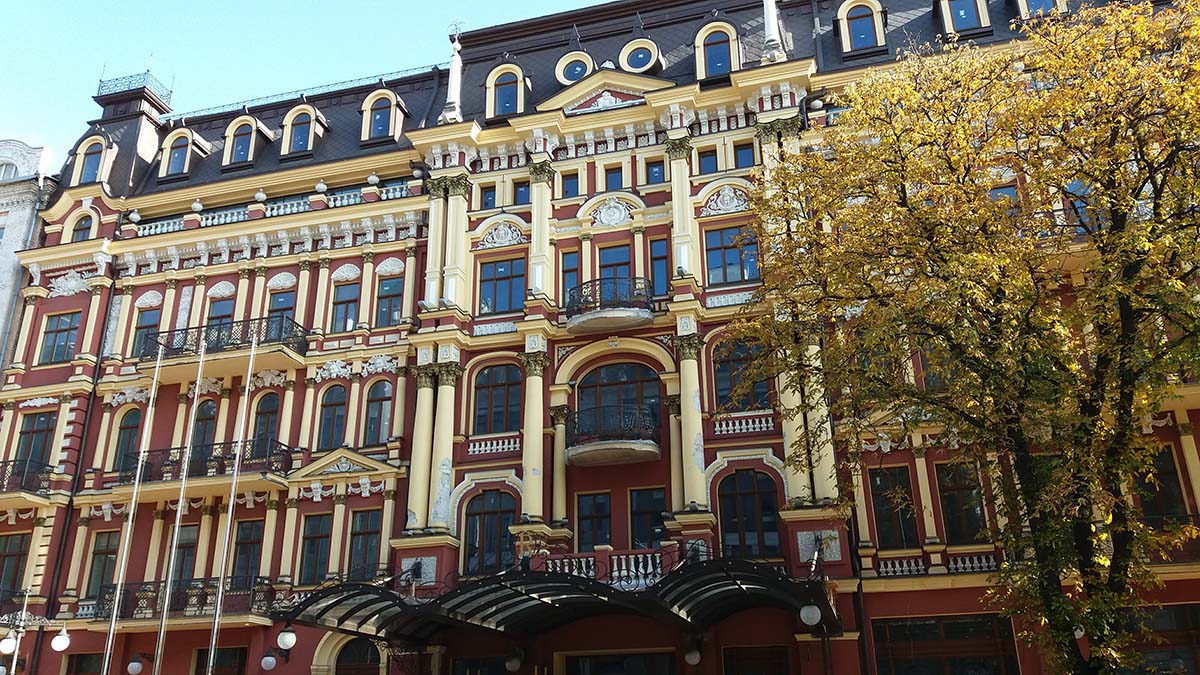At the end of 1899, the land plot where the house now stands was purchased for 125,000 rubles by Nikolai Aleksandrovich Grigorovich-Barsky, the great-grandson of the architect Ivan Grigorovich-Barsky (construction project Church of the Intercession and Nicholas Naberezhny Church, reconstruction project Church of the Assumption of the Virgin Pirogoshhi), and in February of the following year, 1900, he gave it to his son Pavel. The latter wanted to build there the tallest and most luxurious apartment building in Kyiv. Architect Karl Schiemann and engineer Alexander Gilevich were invited to carry out construction work, which began the same year. But Pavel Grigorievich-Barsky’s financial capabilities went against his wishes. His own funds were not enough and therefore he took out several loans against the security of his future home: from a credit union, from the merchant Alexander Sirotkin and from General Viktor Saranchov.
In August 1900, the Kiev press reported that the construction of the “skeleton” of the house was already being completed, and the approximate estimate of the work was about 300,000 rubles. Pavel began negotiations with a number of entrepreneurs regarding the rental of retail space on the ground floor of the building. But the subsequent progress of construction was influenced by several unfavorable factors: at the end of 1900 – beginning of 1901, the “construction boom”, which began in 1898, reached its maximum, as a result of which prices for building materials and labor increased. The funds borrowed for construction ran out, and while the owner was negotiating re-lending, after the “peak” of the “construction boom” in mid-1901, a natural decline began, the real estate market became oversaturated, prices and, accordingly, the profitability of construction fell. Construction of the house stopped; the owner himself, in order to pay off bills, was forced at the end of 1901 to put the unfinished house up for auction. Its winner was Alexander Sirotkin, who, having enough money in 1902-1903, completed the construction, external and internal decoration of the house, installed electric lighting in it and installed an elevator.
The new building housed various shops, a pharmacy, furnished rooms “Palermo” and separate luxury apartments, and in the corner part a confectionery “Marquise” opened. After the establishment of Soviet power in 1917, the building was nationalized. In the 1930s, in the corner room where the Marquise cafe was, there was the Spartak restaurant; in the late 1940s, the first bar in Kiev, the Cocktail Hall, opened here, transformed in the 1950s, as part of the struggle with cosmopolitanism, in the Chaika cafe. Later, when the sister city movement began to develop, “Chaika” was renamed “Leipzig”, in honor of the sister city of Kyiv, and turned into a restaurant serving German cuisine.
The residential part of the house gradually collapsed in the second half of the 20th century, and in 1985-1986 the residents were evicted for major renovations of the building. But due to the difficult economic and political situation in the country, repairs did not begin for a long time; the house was in an uninhabitable condition. In 1992, there was a fire that destroyed part of the interior. It was only in 1997-1999 that the facades were reconstructed, the corner tower, destroyed in the 1950s, and the exterior decoration and painting of the walls were restored.
In 2004, Kyiv sold the house to the Grand Plaza company, which planned to create a five-star Leipzig hotel with 209 rooms in it, but these plans were never brought to life. In 2009, the house was purchased by the company “ISTIL Real Estate”, which also planned to open a hotel in it for Euro 2012. To this end, the new owner even entered into an agreement with the international hotel chain Marriott International to manage a new hotel called Renaissance Kiev Hotel. In 2015, the company “ISTIL Real Estate” froze the reconstruction of the house due to problems with financing.
Where is the house of Sirotkin (Grigorievich-Barsky)?
Proriznaya street, 24


